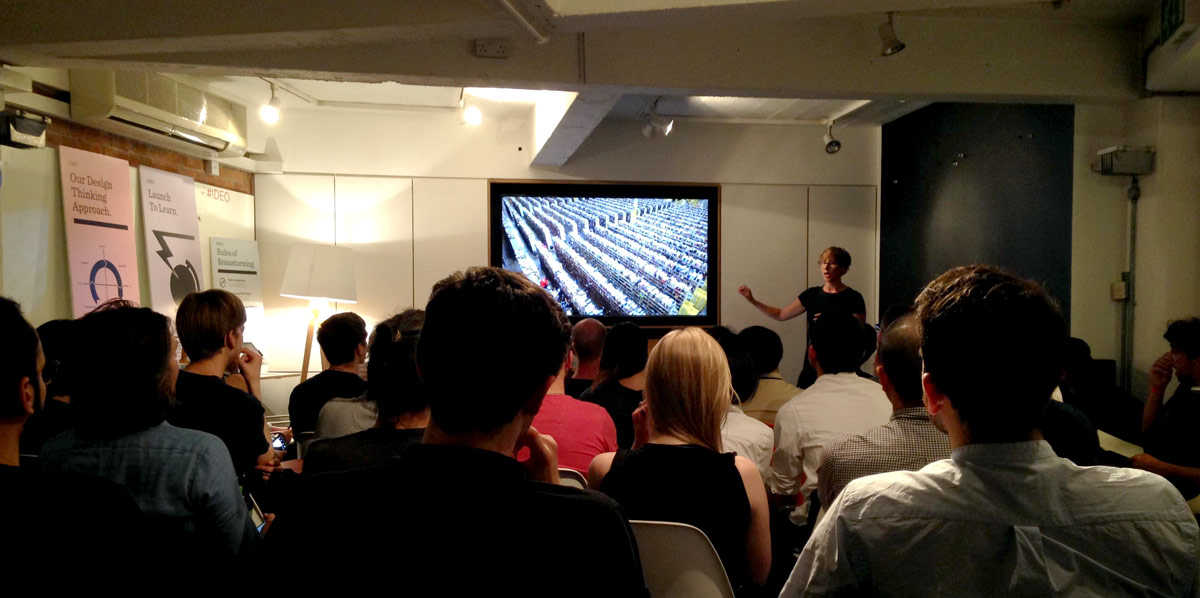Category: IxDA
IxDA London – Implicit Interactions
Last night I guest hosted and organized an IxDA London event on Implicit Interactions at IDEO. Below is the event description.

As the Internet of Things infiltrates the mundane moments of our daily lives, ubiquitously embedding intelligence into objects and environments – our relationships with technology become increasingly dynamic, contextual, and intangible. Therefore as interaction designers, how do we design what could and should be the resulting invisible dialogues between people, places, and things?
This month we will shift our attention away from classic, explicit interaction paradigms – those that demand our attention for direct engagement and manipulation – to implicit interactions that seamlessly behave in the background. Join us for product, prototyping, and research perspectives as we hear from Hongbin Zhuang, CEO and Co-founder of Olly robot; Karey Helms, a Senior Interaction Designer at Zebra Technologies; and Alex Taylor from Microsoft Research.
IxDA London – The Uncanny Valley & Subconscious Biases of Conversational UI
The theme of IxDA London’s June event was Algorithms, Machine Learning, AI and us designers – an evening of great discussions that prompted me to dig up reading material on The Uncanny Valley and Subconscious Biases. Both these topics were strongly present, the former directly and the latter indirectly, in Ed and John’s presentation on designing for IBM Watson. They discussed the ‘Uncanny Valley of Emotion’ as a third line on the curve in addition to ‘still’ and ‘moving’ in the traditional model of the uncanny valley. While I understand their intent in creating a third category – accounting for the invisible systems, agents, and interactions not visible or physically accessible – in retrospect I disagree with the characterization. Emotion, or lack of, can by explicitly betrayed by movement. From my understanding, subtle asynchronous or unnatural movements directly related to emotional responses expected by humans are a key ingredient in the Uncanny Valley. Therefore, I would rename the ’emotion’ curve suggested by the Watson team to ‘implicit,’ thereby retaining emotion as a criteria for both explicit (still and moving) and implicit interactions.

The second subtopic, subconscious biases, greatly concerns me. A recent article in the New York Times – Artificial Intelligence’s White Guy Problem – sums it up perfectly. As designers, how do we build into our processes accountability for subconscious (and conscious) biases relative to algorithms, machine learning, and conversational interfaces? I don’t have an answer but I would like to find one!
Relevant links and resources:
The Uncanny Valley
Uncanny valley: why we find human-like robots and dolls so creepy
Navigating a social world with robot partners: A quantitative cartography of the Uncanny Valley
The Uncanny Wall
Artificial Intelligence’s White Guy Problem
Spring Design & Tech MeetUps

Though work has been keeping me busy, I’ve still been able to partake in a lot of exciting design events around London this past Spring. Some of my favorites being:
- Google partnered with Women Techmakers to host International Women’s Day Summit 2015. Raia Hadsell from Google DeepMind gave an inspiring talk both on Reinforcement Learning as well as presenting her inspiring non-linear career path.
- Gravity Sketch presented their process and prototypes at IxDA London April’s Augmenting space and place. Though I find their product potentially more exciting as a tool for non-creatives, I strongly appreciate rethinking the creative process and mediums of communication and collaboration.
- Chryssa Varna had me feeling all sort of nostalgic for architecture as she presented her beautiful thesis Industrial Improvisation – a poetic combination of robotics and graceful human interaction.
IxDA London – Durrell Bishop
Another great MeetUp by IxDA London! The evening opened with an introductory talk by Dr. Dan Lockton, creator of the Design with Intent toolkit and whose workshop I volunteered for at the DRS 2014 conference this past June, and ended with a presentation and workshop lead by Durrell Bishop.

IxDA London – Wearable Interaction Design
Since moving to London this summer, on the recommendation of friends, I’ve made a strong effort to be proactive in the London MeetUp scene as both an on-going learning experience and opportunity to get to know other designers and technologists. My experiences so far can pretty much be summed up by the regret at only not exploring MeetUp sooner! While I’m a member of quite a handful, my favorite so far have easily been Women Who Code London and IxDA London, both of whom are lead by obviously passionate and motivated individuals, which I believe is what makes their events so coveted.
The most recent IxDA MeetUp was on Wearable Interaction Design, and as one fellow friend and attendee summarized – a mini conference within a single evening. Guest speakers included Melissa Coleman, Kevin McCullagh, Becky Stewart and Duncan Fitzsimons – a diverse range of views regarding wearable technology.

While all the speakers had interesting and varied perspectives, I really appreciated Duncan’s broad and inclusive definition of wearable technology (as seen above). As the subject is too often discussed implying the modification of conventional jewelry with an LED, screen or accelerometer as the future, I believe zooming out and taking a diverse perspective is what will allow for true innovation relative to user-centered needs.
Points of discussion and other thoughts that sprang to mind or stuck included:
- Michio Kaku’s Cave Man Principle in relation to media excitement vs longterm commitment
- Great point by Melissa (if I remember correctly) about wearables not becoming permanently ingrained in our bodies akin to cyborgs, as with the constant release of new technology and versions become obsolete, we will fear our body becoming a technology wasteland
- Becky proposed a great list of suggested conversations to have between a designer and engineer when prototpying, including: tech specifications of data, who needs to see what and when, one way or two way communication, and power requirements among others